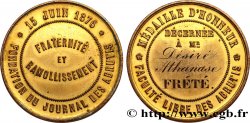fme_851288 - III REPUBLIC Médaille, ville de Lille, Reconnaissance de 43 années de services
75.00 €(Approx. 78.75$ | 63.00£)
Quantity
Add to your cart

Type : Médaille, ville de Lille, Reconnaissance de 43 années de services
Date: n.d.
Mint name / Town : 59 - Lille
Metal : silver
Millesimal fineness : 850 ‰
Diameter : 45 mm
Orientation dies : 12 h.
Engraver DUBOIS Alphée (1831-1905)
Weight : 47,66 g.
Edge : lisse + corne 2ARGENT
Puncheon : Corne 2 ARGENT
Coments on the condition:
Patine grise hétérogène, de l’usure sur les hauts reliefs. Quelques taches d’oxydation
Obverse
Obverse legend : VILLE DE LILLE.
Obverse description : Représentation féminine à gauche, un écu de la ville sur son épaule, avec une branche de chêne ; vue de la Grand Place avec sa colonne en arrière plan. Signé : LEON HODEBERT INV. - ALPHEE DUBOIS SC..
Reverse
Reverse legend : A / MONSIEUR / LOUIS BOURGOGNE / INSTITUTEUR / EN RECONNAISSANCE / DE SES 43 ANNEES / DE SERVICES.
Reverse description : Légende en 7 lignes gravée à droite de branches de chêne et de laurier. Signé : L. H. INV. - A. D. SC..
Commentary
Médaille décernée à Monsieur Louis Bourgogne, instituteur, pour ses 43 années de serices.
Dressée au milieu de la Grand Place, la colonne commémore le siège de Lille par les Autrichiens en septembre 1792. Dans la main droite, la Déesse de bronze tient un ‘boutefeu’ qui sert à allumer la mèche des canons. Sa main gauche indique une inscription gravée sur le socle : la réponse courageuse du maire de Lille, André, refusant de rendre sa ville assiégée. Cette victoire fut aussi saluée par la Convention Nationale, proclamant que « Lille avait bien mérité de la patrie ». Le monument, dessiné par l’architecte Charles Benvignat a été érigé en 1845. Le sculpteur de la Déesse est le douaisien Théophile Bra, également auteur de deux bas-reliefs sur l’Arc de Triomphe à Paris.
Dressée au milieu de la Grand Place, la colonne commémore le siège de Lille par les Autrichiens en septembre 1792. Dans la main droite, la Déesse de bronze tient un ‘boutefeu’ qui sert à allumer la mèche des canons. Sa main gauche indique une inscription gravée sur le socle : la réponse courageuse du maire de Lille, André, refusant de rendre sa ville assiégée. Cette victoire fut aussi saluée par la Convention Nationale, proclamant que « Lille avait bien mérité de la patrie ». Le monument, dessiné par l’architecte Charles Benvignat a été érigé en 1845. Le sculpteur de la Déesse est le douaisien Théophile Bra, également auteur de deux bas-reliefs sur l’Arc de Triomphe à Paris.








 Report a mistake
Report a mistake Print the page
Print the page Share my selection
Share my selection Ask a question
Ask a question Consign / sell
Consign / sell
 Full data
Full data









